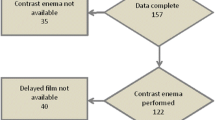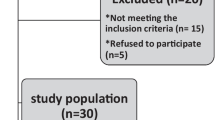Abstract
Objective
To determine whether Hidradenitis suppurativa (HS)-related anoperineal disease can be distinguished from Crohn’s disease (CD) using MRI.
Methods
Pelvic MRI of 23 HS and 46 CD patients with anoperineal disease between 2007 and 2014 were independently analysed by two radiologists. For diagnosis of HS, sensitivity, specificity and positive likelihood ratios (LRs) of inflammatory features and of their anatomical distribution were calculated and compared to those of CD.
Results
In HS, fistulae were less present (P = .033) and less frequently involved the sphincters (P = .001) than in CD. Granulomas were more frequent (P = .0005). For anterior/inguinal and posterior localizations, sensitivity, specificity and LR for diagnosis of HS were 70% (49.1, 84.4), 87% (74.3, 93.9), 5.3 (2.41, 11.79) and 57% (36.8, 74.4), 93% (82.5, 97.8), 8.67 (2.74, 27.41), respectively. Combination of signs including posterior involvement, absence of rectal wall thickening and bilaterality of features yielded specificity of 100% (95% CI: 92.3–100) for HS.
Conclusion
Although MRI presentations of anoperineal disease may overlap between CD and HS, specific diagnosis of HS is possible with a combination of three features: absence of features’ predominance in perianal area, absence of rectal wall thickening and bilaterality of features.
Key Points
• Spectrum of MRI features of HS-related anoperineal disease is wide.
• Specific diagnosis of HS-related anoperineal disease is possible using MR imaging.
• A combination of three MR signs allows distinction between HS and CD.





Similar content being viewed by others
References
Alikhan A, Lynch PJ, Eisen DB (2009) Hidradenitis suppurativa: a comprehensive review. J Am Acad Dermatol 60:539–561
Jansen I, Altmeyer P, Piewig G (2001) Acne inversa (alias hidradenitis suppurativa). J Eur Acad Dermatol Venereol 15:532–540
Cosmatos I, Matcho A, Weinstein R (2013) Analysis of patient claims data to determine the prevalence of hidradenitis suppurativa in the United States. J Am Acad Dermatol 68:412–419
Kimball AB, Kerdel F, Adams D et al (2012) Adalimumab for the treatment of moderate to severe hidradenitis suppurativa: a parallel randomized trial. Ann Intern Med 157:846–855
Jemec GBE (2012) Hidradenitis suppurativa. N Engl J Med 366:158–164
McMillan K (2014) Hidradenitis suppurativa: number of diagnosed patients, demographic characteristics, and treatment patterns in the United States. Am J Epidemiol 179:1477–1483
Dessinioti C, Katsambas A, Antoniou C (2014) Hidradenitis suppurrativa (acne inversa) as a systemic disease. Clin Dermatol 32:397–408
Dambha F, Tanner J, Carroll N (2014) Diagnostic imaging in Crohn's disease: what is the new gold standard? Best Pract Res Clin Gastroenterol 28:421–436
Régimbeau JM, Panis Y, De Parades V, Marteau P, Valleur P (2000) Anoperineal manifestations of Crohn's disease. Gastroenterol Clin Biol 24:36–47
Taylor SA, Halligan S, Bartram CI (2003) Pilonidal sinus disease: MR imaging distinction from fistula in ano. Radiology 226:662–667
Taylor SA, Avni F, Cronin CG et al (2016) The first joint ESGAR/ESPR consensus statement on the technical performance of cross-sectional small bowel and colonic imaging. Eur Radiol
Kelly AM, Cronin P (2005) MRI features of hidradenitis suppurativa and review of the literature. AJR Am J Roentgenol 185:1201–1204
Griffin N, Williams AB, Anderson S et al (2014) Hidradenitis suppurativa: MRI features in anogenital disease. Dis Colon Rectum 57:762–771
Yazdanyar S, Miller IM, Jemec GB (2010) Hidradenitis suppurativa and Crohn's disease: two cases that support an association. Acta Dermatovenerol Alp Pannonica Adriat 19:23–25
van der Zee HH, van der Woude CJ, Florencia EF, Prens EP (2010) Hidradenitis suppurativa and inflammatory bowel disease: are they associated? Results of a pilot study. Br J Dermatol 162:195–197
Church JM, Fazio VW, Lavery IC, Oakley JR, Milsom JW (1993) The differential diagnosis and comorbidity of hidradenitis suppurativa and perianal Crohn's disease. Int J Color Dis 8:117–119
Hidradenitis Suppurativa Foundation (2009) San Diego, California 92129 [on line] http://www.hs-foundation.org. Published September 2005. Accessed 15 Nov 2015
Dohan A, Eveno C, Oprea R et al (2014) Diffusion-weighted MR imaging for the diagnosis of abscess complicating fistula-in-ano: preliminary experience. Eur Radiol 24:2906–2915
Parks AG, Gordon PH, Hardcastle JD (1976) A classification of fistula-in-ano. Br J Surg 63:1–12
De Miguel Criado J, del Salto LG, Rivas PF et al (2012) MR imaging evaluation of perianal fistulas: spectrum of imaging features. Radiographics 32:175–194
Jaeschke R, Guyatt GH, Sackett DL (1994) Users’ guides to the medical literature. III. How to use an article about a diagnostic test. B. What are the results and will they help me in caring for my patients? The Evidence-Based Medicine Working Group. JAMA 271:703–707
Burrows NP, Jones RR (1992) Crohn's disease in association with hidradenitis suppurativa. Br J Dermatol 126:523
Revuz J (2009) Hidradenitis suppurativa. J Eur Acad Dermatol Venereol 23:985–998
Acknowledgements
The authors thank Dr. Luc Vandromme for his contribution to this research. The scientific guarantor of this publication is Prof. Christine Hoeffel. The authors of this manuscript declare no relationships with any companies whose products or services may be related to the subject matter of the article. The authors state that this work has not received any funding. One of the authors has significant statistical expertise. Written informed consent was waived by the Institutional Review Board. Institutional Review Board approval was obtained. Methodology: retrospective, diagnostic or prognostic study/observational, multicentre study
Author information
Authors and Affiliations
Corresponding author
Rights and permissions
About this article
Cite this article
Monnier, L., Dohan, A., Amara, N. et al. Anoperineal disease in Hidradenitis Suppurativa : MR imaging distinction from perianal Crohn’s disease. Eur Radiol 27, 4100–4109 (2017). https://doi.org/10.1007/s00330-017-4776-1
Received:
Revised:
Accepted:
Published:
Issue Date:
DOI: https://doi.org/10.1007/s00330-017-4776-1




